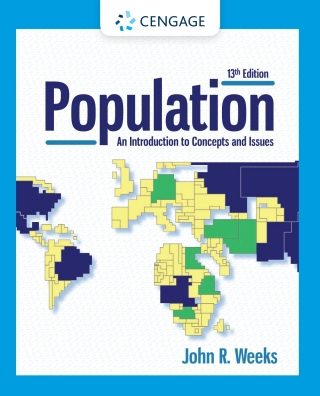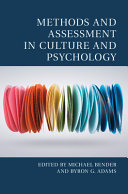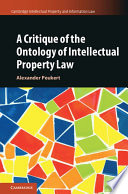Buy Population: An Introduction to Concepts and Issues, 13th Edition PDF ebook by author John R. Weeks – published by Cengage Learning in 2021 and save up to 80% compared to the print version of this textbook. With PDF version of this textbook, not only save you money, you can also highlight, add text, underline add post-it notes, bookmarks to pages, instantly search for the major terms or chapter titles, etc.
You can search our site for other versions of the Population: An Introduction to Concepts and Issues, 13th Edition PDF ebook. You can also search for others PDF ebooks from publisher Cengage Learning, as well as from your favorite authors. We have thousands of online textbooks and course materials (mostly in PDF) that you can download immediately after purchase.
Note: e-textBooks do not come with access codes, CDs/DVDs, workbooks, and other supplemental items.
eBook Details:
Full title: Population: An Introduction to Concepts and Issues, 13th Edition
Edition: 13th
Copyright year: 2021
Publisher: Cengage Learning
Author: John R. Weeks
ISBN: 9780357038260, 9780357038260
Format: PDF
Description of Population: An Introduction to Concepts and Issues, 13th Edition:
Any class in Population/Demography is a lot more interesting when you are using this book. POPULATION does more than give you information; it also shows you how to put it into practice. From the debates over how to manage population growth in some countries, and aging populations in others, to the issues of how amazingly different the world is when people are living in urban areas with considerable control over their own mortality and fertility, POPULATION helps you understand how the world really works and how population dynamics relate to socio-economic transitions and sustainable development. You’ll find compelling writing, intriguing essays and built-in study aids that help you review and prepare for tests — while also equipping you for the rest of your life on this planet.Important Notice: Media content referenced within the product description or the product text may not be available in the ebook version.
Table of Contents of Population: An Introduction to Concepts and Issues, 13th Edition PDF ebook:
Brief Table of ContentsDetailed Table of ContentsPrefacePart 1: A Demographic PerspectiveChapter 1: Introduction to DemographyWhat Is Demography?How Does Demography Connect the Dots?World Population GrowthGeographic Distribution of the World’s PopulationGlobal Variation in Population Size and GrowthSummary and ConclusionMain PointsQuestions for ReviewChapter 2: Demographic Data and Applied DemographyPopulation CensusesRegistration of Vital EventsCombining the Census and Vital StatisticsAdministrative DataSample SurveysHistorical SourcesSpatial DemographyApplied DemographyShould You Pursue a Career in Demographics?Summary and ConclusionMain PointsQuestions for ReviewChapter 3: Demographic Perspectives and TheoriesPremodern Population DoctrinesThe Prelude to MalthusThe Malthusian PerspectiveThe Marxian PerspectiveThe Prelude to the Demographic Transition TheoryThe Theory of the Demographic TransitionThe Theory of the Second Demographic TransitionThe Demographic Transition Is Really a Set of TransitionsSummary and ConclusionMain PointsQuestions for ReviewPart 2: Population ProcessesChapter 4: The Health and Mortality TransitionDefining the Health and Mortality TransitionHealth and Mortality Changes Over TimeLife Span and LongevityDisease and Death Over the Life CycleCauses of Poor Health and DeathMeasuring MortalityHealth and Mortality InequalitiesSummary and ConclusionMain PointsQuestions for ReviewChapter 5: The Fertility TransitionWhat Is the Fertility Transition?How High Could Fertility Levels Be?Why Was Fertility High for Most of Human History?The Preconditions for a Decline in FertilityIdeational Changes That Must Take PlaceMotivations for Lower Fertility LevelsHow Can Fertility Be Controlled?How Do We Measure Changes in Fertility?How Is the Fertility Transition Accomplished?Geographic Variability in the Fertility TransitionCase Studies in the Fertility TransitionSummary and ConclusionMain PointsQuestions for ReviewChapter 6: The Migration TransitionWhat Is the Migration Transition?Defining MigrationMeasuring MigrationWhy Do People Migrate?Migration Within the United StatesGlobal Patterns of MigrationAmerica’s Immigration TrendsCanada’s Immigration TrendsForced MigrationImpact of Migration on SocietySummary and ConclusionMain PointsQuestions for ReviewChapter 7: The Urban TransitionWhat Is the Urban Transition?Defining Urban PlacesThe Historical Pattern of the Urban TransitionThe Proximate Determinants of the Urban TransitionThe Urban HierarchyThe Urban Evolution That Accompanies the Urban TransitionSummary and ConclusionMain PointsQuestions for ReviewPart 3: Using the Demographic PerspectiveChapter 8: The Age Transition and the Life CourseWhat Is the Age Transition?The Concepts of Age and SexDemographic Drivers of the Age TransitionDemographic Dividends-Age Transitions at WorkThe Life Course and Population AgingReading the Future from the Age StructureSummary and ConclusionMain PointsQuestions for ReviewChapter 9: Family Demography and Life ChancesDefining Family Demography and Life ChancesProximate Determinants of Family and Household ChangesChanging Life ChancesSummary and ConclusionMain PointsQuestions for ReviewChapter 10: Population, the Environment, and Global SustainabilityThe Use and Abuse of the Earth’s ResourcesHow Is Population Related to Economic Development?Can Billions More Be Fed, Given Our Environmental Issues?The Demand for Food Is Growing Faster Than the PopulationThe Environmental Constraints to Growing More FoodHuman Dimensions of Environmental ChangeSustainable Development-Possibility or Oxymoron?Policies Aimed at Slowing Population GrowthSummary and ConclusionMain PointsQuestions for ReviewGlossaryBibliographyGeographic IndexSubject Index





